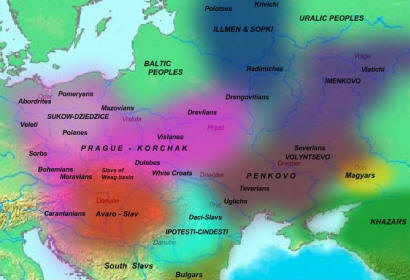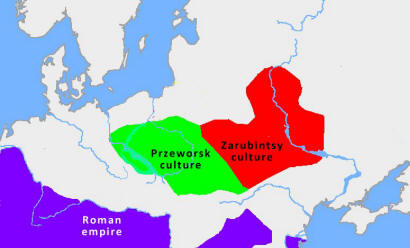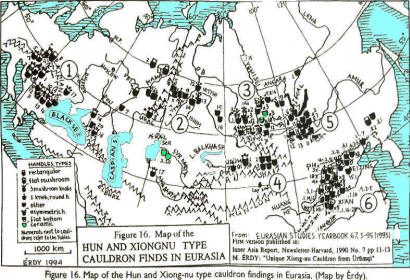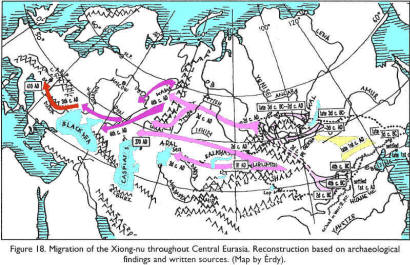§1. Imenkov monetary-weight systemMonetary circulation is a social process of
emergence not only of a monetary circulation, but also of a large number of centrally
weight-normalized metallic money and their intensive circulation, indicating organization of a
state.
Study of the history of the early-medieval monetary circulation in the Itil, Urals, and North
Caucasus regions allows to see there not a “Wild field”, as this process was interpreted by some
Soviet historians, but the successive confederations of tribes or states of the Huns, Khazars,
Bulgars, etc.
To the first, or the earliest, period monetary circulation in the Itil and Urals regions belong
the metallic money - the bronze ingots (sums) found in settlements and rich burials “metal castings
for further distribution, probably to exchange”, as noted V.F. Gening who discovered during
excavations such bars in the Turayev Vb. kurgan cemetery.1
|
The incipient Rus inherited the custom of ingot money, called in Slavic grivna (гривна), the use of
grivna continued in the Rus through the 15th c., also under its northern name
rubl (рубль). Both grivna and
rubl are the names of the modern currency, grivna in the Ukraine, and
rubl in Russia.
The Russian historiography pretends that it has no clue where the grivnas
came from. Since the Rus was a splinter of the Khazar Kaganate, the “Khazar Kingdom” is somewhat
mentioned in the Russian historiography, but the previous Bulgar, Avar, and Hunnic periods are
beyond the historical Russian horizon. Hence, the Russian grivna does not have a defined
origin. Not yet. Since the historical hushing is not an open falsification, in the official Russia
it is not rated as falsification.
That peculiar historiographical tradition was started during the
reign of the Peter I, when invited luminaries were to create the “History of Russian state” or
“History of the House of Romanov” from scratch. neither history was to cover the people of the land,
and they did it with excellence. Oceans of paper were spent to spread the history where the word
“Russians” was an adjective, and the word “Tatars” was a noun. Nothing much has changed since in
that funny historiography. |
He noted the cultural affinity of the tribes, and wrote that Turayev-type ceramics is extremely close
to that of the Imenkovo-type in the the Kama area, and suggested their synchronicity, i.e.
simultaneous arrival of the Imenkov and Romanov-type ceramics with the Turayev-type ceramics and
populations that occupied the entire Middle Itil, Lower Kama, and the middle course of the White
river (Fig. 17).2
Indeed, later in the settlements of that region archaeologists found a large number of bronze ingots,
including workshops for casting such ingots, with numerous finished products (in the Imenkov
settlement) (Fig. 19).
| Fig. 17. Tribes of Itil and Urals regions that appeared in the era of the “Great
Migration of Peoples” in 3rd - 4th cc. (according to V.F.Gening) |
Figure 19. Бronze ingots |
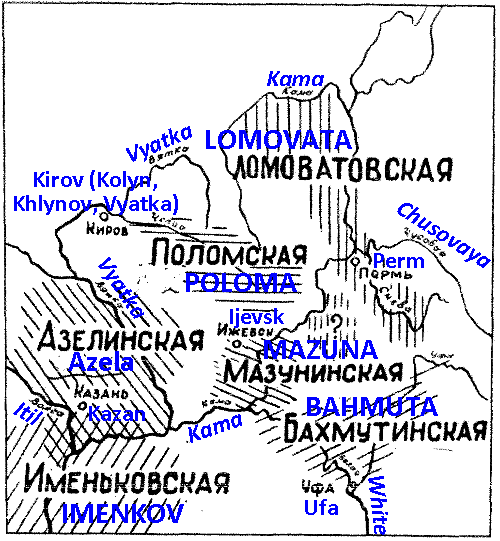 |
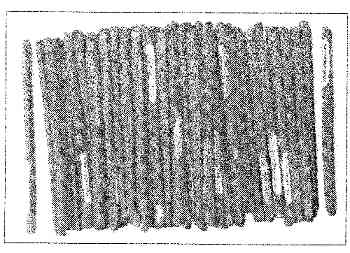 |
With respect to the newcomer groups of the 3rd -5th cc., whose kurgans were
investigated by V.F. Gening, referring to the relatively late Arab synopses, he suggested that they
were Burtas tribes.
|
It is generally believed that Burtases were Mordva, mentioned by the Classical authors in the area
of the Middle Itil. However, the Fennic Mordva were foot hunters, were not Tengrians, and did not
build kurgans. V.F. Gening, an experienced archeologist, must have known that very well. His “Burtases”
were nomadic, were Tengrians, and did build kurgans. At the time, the only way to continue studies
without harassment and persecution of himself and his family was to label the subject as something
palatable to the powers to be, which was a menu selection of Slavs, Iranians, and Finns, in that
order.
The connection Burtas ~ Mordva is based on the location and m/b alternation, typical
in the Itil area: Burtas > Murdas > Mordva. The Türkic name for Mordva is Modjar, which is a
phonetic rendition of the ethnonym Magyar. |
Historians and archaeologists also have other, sometimes fantastic, ideas
about their ethnical affiliation, in particularly of the Imenkov tribes. At that, is hushed that
Imenkovs had fairly developed social structure and intense metallic monetary circulation, which
later grew into the coinage of the Khazars and Bulgars.
Before plunging into the Imenkov monetary-weight circulation system, we will attempt to sort out who were
those tribes that appeared almost simultaneously in the Itil and Urals regions in the course of the “Great
Migration of Peoples”?
1 Gening V.F. Turaev cemetery in 5th c./From Itil-Kama Archaeology. - Kazan, 1976.
2 Ibid. p. 107.
62
| Fig.
18. Movement of Ugrs (Ogors) to the Upper Kama (according to V. F.Gening) |
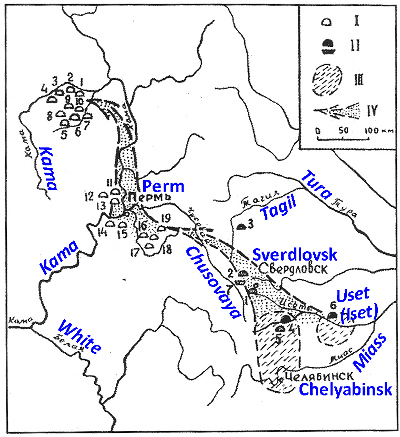 |
We have to admit that even such a talented and objective historian as V.F. Gening, after the
devastating resolution of the (Communist Party of Soviet Union) Central Committee
“On
condition and improvement measures for mass-political and ideological work in the Tatar party
organization” of 1944, like the other historians and
archaeologists, had to write only in a negative sense about the Huns. He divvied to them only a
minor role in the history of the Itil and Ural area, and also described them as a source of threat or invasion
that
resulted in the mass “migration of peoples” in the 3rd - 4th cc. to that region (Fig. 18).
But was there an invasion at all?
The
European scientists of the 18th c. explained many natural phenomena by cataclysms, i.e. natural
disasters and calamities. They sought to explain the same way, not without a bias, the the not
understood or
insufficiently researched historical events. For example, the collapse of the moribund backward Roman slave-holding
system under an onslaught of new feudal relations, introduced by the Huns, they explained with the
so-called invasion of the Huns, who, incidentally, indeed were destroyers of the predatory slave-holding systems from
China and Persia to Rome. The powerful eastern empire of the Huns in the north of China, had existed
for nearly three centuries, a normal duration for any ancient and medieval states, it split naturally into
separate kingdoms still in the early our era.
63
The European scientists of the new time were already writing works about the Itil Huns' state at
a full blast, while the Soviet historians still were chewing on the myth of the “Hunic invasion”. As a result of
this “invasion” for some reasons the “Great Migration of Peoples” mainly fell only on the Itil and Ural regions.
To be fair, a concentrated on the Huns historian A.N.Bernshtam in a cautious manner noted that before the European
campaign for nearly two centuries the Huns were “accumulating” in the Southern Urals.1
A famous ethnically Tatar scientist, a Sorbonne professor Sadri Maksoud Areal, with references to multiple sources,
and to the work of the German historian Hirth (“Huns on the Itil”), wrote that according to the
plan of destruction the fragmented Huns approved by the (Chinese) emperor,
in 93 AD began a general Chinese
offensive, they executed anybody who fell into their hands. A part of the defeated Huns retreated to
the Altai, and some broke through to the Itil, and created a new Hunnic state between the Urals,
Itil and the Caucasus.2
The invasions, or large organized military campaigns, as evidenced by the historical examples,
could be
carried out in the period of creation, blossoming of the states and empires, and not a few centuries
after their breakup.
Thus, was completely disregarded the creation not only of the new Hunnic state, but also of the
sufficiently long enough period
of its development and blossom. During that period, the Hun state becomes a real force, capable not
only to come to the international arena, and not only to face the equal to China in might another slave-holding Roman Empire, but also
to destroy it; on its ruins later arose new feudal states of
the Europe.
In respect to the barbarism of the Huns it should be stated that it is too was exaggerated by tendentious fabrications
of the authors of the type like the Roman the court historian of the 4th c. Ammian Marcellin, who is often quoted by
the modern textbook
editions because of his sharply negative attitude toward the Huns. Many negative traits
he ascribed to the Huns were taken from the older sources. For example, that the Huns did not know
a fire, and therefore to cook raw meat they laid it on the backs of horses, galloped, and then ate
the so “cooked” meat,
he copied word for word from the Herodotus writings, who attributed such meat “cooking techniques”
to a some particularly savage tribe of the ancient Scythians.
Now we know that the Huns had their written language, that a part of the Itil and Urals Huns professed Buddhism
and Hinduism of an early form. From the archaeological excavations in the Baikal region settlements
is
known that before their migration, the Huns knew brick construction, and they knew cast iron a thousand years before the
Europeans. In the Altai kurgans, because of the natural conditions of permafrost, were preserved and
reached us the objects of magnificent works of the Hun's art, like carpet embroidery or thousands of
sculptures made by artistic casting. In the Turayev kurgans in the Kama area was found an
interesting and rich collection of weaponry: daggers, chain link helmets, chain link arms, stirrups, and long
two-handed steel swords, yet unknown in Europe.
Located between the Kuban (according to ancient Armenian sources Hunan, Kuman, Kuban, i.e. the land of Huns)3 and the North Ural region Sibir (after the name of the city Isker, i.e.
the land of Iskils)
the major tribal alliance or early feudal state of the Hunnic-Ugrian tribes existed from the 3rd to
the 7th cc. For it, like for any other feudal state, was typical a progressively developing commodity-monetary relations, which
in the later Khazar and Bulgar states grew into coin minting and
monetary circulation.уи
1 Bernstam A.N. Essays on history of the Huns. - Leningrad, 1951.
2 Sadri Maksudi Areal. Türkic history and law. - Kazan, 2002.
3 Gukasyan V.L. Türkizms in Albanian sources / / ST. - 1977. No 2.
64
That was an alliance of the Hunnic and Finno-Ugric early medieval Ogor tribes, the meaning
of the term is the concept “union”, i.e. a state. This Hunnic word explained S.Maksudi, this
is the ancient Türkic oguz, i.e. tribal
confederacy, altered in the West as a result of rhotacism, perhaps
under an influence of the Finno-Ugric language.
It looks that the bulk
of the Ugro-Finns came to the Itil and Urals regions in the 3rd century from the east together with the Huns, because they had higher
culture, on the overall similar to the Huns' culture, than the local population of older rare and small
clan settlements. V.F. Gening, who traced migration of the tribes archaeologically, calls them with the general
term “Ugric peoples”.
Very important and interesting is the fact that in this period of early feudal state formation а
mass of the Huns came to the Itil region not only from the east or south, but also from the
southwest from the N.Pontic and the North Caucasus. For example, one of the major tribes
were Savirs that in the form Sapir are mentioned by Apollonius of Rhodes still in the 3rd c. BC in the
N.Pontic, i.e. during the existence of the Zarubinets culture. Stephen of Byzantium in his
vast geographical dictionary reports that Sapirs are the people of the Pontic region, now called
with b - Sabirs.1
Later, the Savirs or Suvars are often mentioned in the North Caucasus and the Itil region. They
Likely, in appearance they differed from the eastern Huns, because they were often called
“European Huns”. For example, historian Makian, who lived in the 4th c., tells that “on the ground for Borysthenes Alans inhabit the so-called
“European Huns”.2 Thus, it seems, for the first time
we meet not only
with the self-designation endonym, but also with Imenkov migration, who according to the
archaeological data moved from the southwest from beyond the Itil.3
The message of Stephen of Byzantium about Savirs as “people of Pontus region”, the subsequent
mentions of Savirs
or Suvars in the North Caucasus and in the Middle Itil, where during the Middle Ages stood a city of the same
name (Nur-Suvar), shows that not everything can be explained
with the “Hunnic invasion”, and that the western sources of the Imenkov
culture during the “assembling of the state” period are not accidental.
From the outset, the Huns' supreme power looked at the other peoples as allies and trading partners.
The history of the
Itil and Ural does not know examples of linguistic or religious oppression of tribes or peoples at
a level of national
scale. Such federation was quite strong, because is was based on voluntary confederation. Its
weakness was the local princes who could grow disgruntled with the policy of the federal power and
secede at any time, thus weakening the state. The Hun state practiced such federal form of organization
of the tribes even much earlier. The Chinese historians have noted, for example, that Kangar/Kangju
was a state, i.e. political, and not ethnic entity, which ruled many other subordinated “possessions”.4
1 Latyshev V.V. Reports of the ancient writers, Greek
and Latin, about Scythia and Caucasus, SPb, 1904-1906, Part 1-2, pp. 262, 413
2 Ibid.
3 Gening V.F. Essay on Kama ethnic cultures in the Iron Age.//Proceedings of KFAN, 1959, p.183.
4 Bichurin N. Ya. Collection of information on peoples in Central Asia in ancient times, Leningrad, 1950. - Vol. 2. p. 186.
65
Evidently, due to the written sources, we also know the brief ancient history of the launch of
the Empire of the Huns and Ugro-Finns
between the Urals and the Caucasus. The ancient geographer Ptolemy of the 2nd c. first mentions the Huns
together with Sarmats in the Caspian depression.1
A Byzantine historian Theophylact Simocatta, a contemporary of Emperor Maurice and Phocas (582-610),
writes that one of the “oldest leaders” of the Ogor tribe was called Hunni. It is noteworthy that Simocatta mentions
him in connection with the story of the tribes “living near the Caucasus
and extending to the North”.2 It should be added that Ogors apparently really lived in the
north, in the Itil and Urals region. It is known that in the 6th c. the Türkic Kagan first
defeated Ogors, and then went to the Caucasus against the Colchis. The word Ogors (Onogurs,
Kuturogurs, Utraogurs, etc.) is not an ethnonym of a tribe. In the ancient Türkic language the word is a
phonetic variant of the word Oguz meaning a “Union of tribes”.3
The records about the Hunni's activities could be taken as a possible coincident, if about him, i.e. about the
“leader Hunni of the Huns” and his actions did not record in more detail the Chinese chronicles,
completely independent from the Byzantine sources.
It should be noted that the Chinese sources of that time, talking about the Huns, refer
specifically to them, and not to the northern tribes at large, they are more consistent and are
better informed about the ongoing political struggles
through the Huns, who renewed their ties with the Chinese. For
example, of exceptional interest is the message of the historians of the younger Han dynasty
(Later Han, 後漢書, Houhon Shu) that the possession which preceded
the Huns, the “possession Yantsai (Yancai, 奄蔡 = Vast steppe = Tr.
Alan) was renamed to Alanya (Alanliao 阿蘭聊)”.4
Apparently, that was the initial
period of the Hun dominations, when disappeared the Sarmatian tribal union and appeared a new,
more powerful confederacy of the Alan tribes, of which Ammianus Marcellinus wrote, “little by
little, they subjugated in many victories the neighboring nations, and spread their name on them...”.
Apparently, the Huns subsequently annexed the northern allied tribes of the Suvar Huns (Imenkovs),
etc. The history of the house Wei House (Book of Wei, 魏書, Wei Shu)
of the 5th c. reported on the seizure of power by the Huns, “Once the
Huns, killing The Sude ruler, seized his lands. The Ruler Hunni was a fourth generation after that
event.”
The city Sude of Chinese sources may be the Suvar broadly or the city Sibir (Isker), which on the
brothers Pizzigani maps of the 1367 is shown slightly north-east of the Bulgar cities on the left bank of the Kama
river.
During the Kipchak Khanate (author: Golden Horde) it was a
prominent, rich with furs city that became the capital of the Siberian Khanate.
Archeologists have traced a more ancient “Ostyak” layer of the fort.5
Pizzigani AD 1367 map showing relative location of
Kama, Itil and Don cities
200 years before the quite non-Mongol Russian army destroyed
them
and 550 years before the Russian textbooks, encyclopedias, and historians instituted systematic
fraud
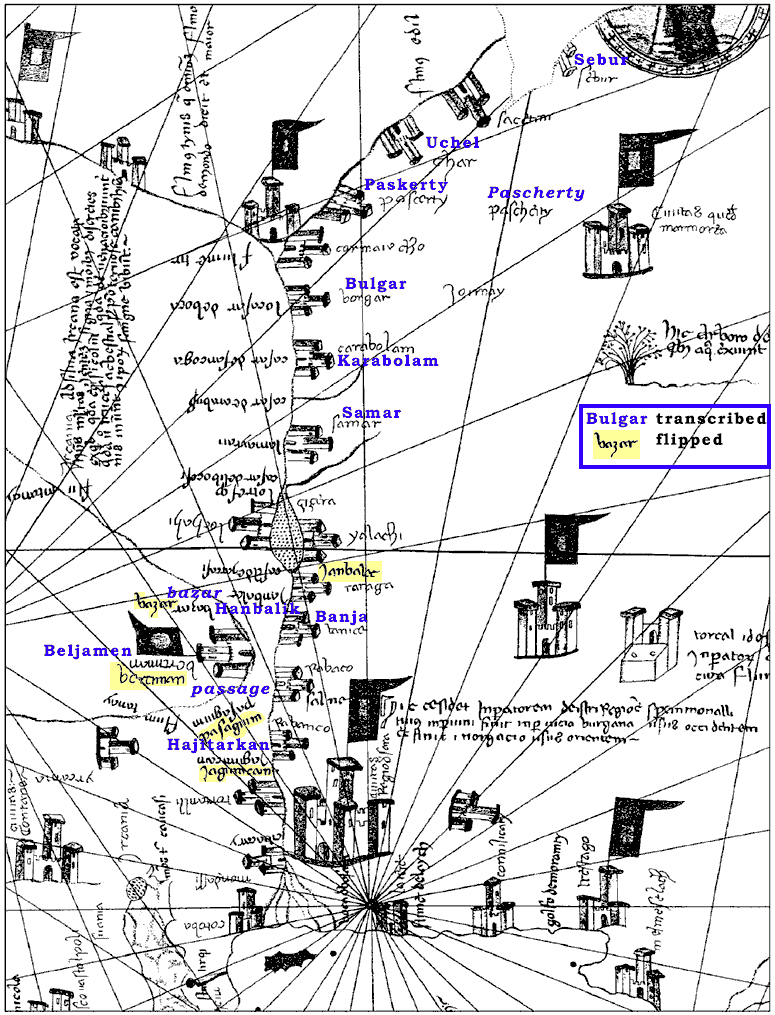
|
Thus, the minting of the coins, which appeared later in the capital city Itil or Hazaran (Khazaran, “Khazars'
land”) did not come about from nowhere. It was preceded in the Itil and Urals area an
intensive circulation of cast metal money of their own production, the bronze ingots.
The bronze ingots as commodity money, i.e. raw material used for the manufacture of brass ornaments and
various handicrafts, were more widespread than the vessels of precious metal (Fig. 19).
1 Ptolemy K. Geography. Antique geography. Moscow, 1953. p. 321.
2 Simocatta Th. History. Moscow, 1957. p. 159.
3 Sadri Maksudi Areal. Türkic history and law. Kazan, 2002, p. 317.
4 Bichurin N. Ya. Op. Cited, V.2. p. 229.
5 Pignatti V.N. Isker (Kuchum's city)//Yearbook of Tobolsk museum. 1915. Vol. 25. p. 20.
66
The enterprising Imenkovs had workshops where such ingots were cast. For the earlier periods, were
critical the level of social development and the availability of.
The raw material components for casting bronze ingots were brought from the Ural range, Imenkovs
had strong contacts with its tribes. A distinctive feature was that artisans made them by not
on order, as other objects, but sale to those who sought raw materials for casting various
products. So gradually, the bars were becoming “commodity of commodities”, i.e. “intermediaries” at
the exchanges.
|
While the suggested model for the rise of the unit of exchange is convincing, the postulation of
free trade between the consumers and producers of raw materials is not supported by historical
examples. The documented examples always describe the supply side as tributary dependents, obligated
to supply a prescribed inventory in defined quantities in exchange for allied relations, patronage,
or marital union. The tributary system ensured a sufficient and constantly replenished stock of raw
materials. The distribution on the consumer side may have been a patronage or a free trade. Thus,
although the ingots could have served as monetary units on both sides, the supply of the raw
materials was outside of the free market. This social compact is known from the first records on the
chain of supply well into the Modern Age. The social contrast between the two sides of the exchange
remained distinct and acute.
The tributary aspect of the Urals ore production is attested by the
toponym Kyshtim for the ore-mining area, in Türkic kyshtim is “tributary, subordinate”, and
like other Türkic generic appellations, it became a local substitute for ethnonym, and eventually
toponym. |
If a fairly valuable vessel of precious metal was used for collective sacrifices to the protector
of the tribe,
Buddha or Tengri, the discovery of bronze ingots among the personal belongings buried in the cemeteries,
kurgans, or found in the cultural layers of the fortifications indicates that they were fairly widespread
as a form
of personal property and equivalent at exchanges. While the vessels as precious metal objects needed
an evaluation, the bronze ingots, with guaranteed quality and permanent weight established by the
ruling power, did not need such an assessment, which also contributed to their
wide distribution as “intermediaries” of exchange.
|
In both instances, buried or sediment, the function of the monetary units is the same, it is a
necessity needed for living or for a travel to Tengri for reincarnation. The deceased were furnished
with the same travel necessities as they needed for travel during their lifetime, stone implements
in the Stone Age, metal implements in the Metal Age, and monetary implements in the Money Age. |
The earliest known bronze ingots were found in rich kurgans near the village Turaevo of the Elabuga
district in Tatarstan, dated by the end of 4th - the beginning of 5th c. The unique Turayevo
cemetery contains burials with interred military commanders with rich complement of weaponry, left
by the tribes related to the Imenkovs.1 The ingots were about 1 X 1 cm square
cross-section metal rods 20 cm in length. Apparently, they were cast for internal exchange and distribution, but
a final form (triangular cross-section
tapered at the ends) they attained later, and more widespread distribution of the ingots, that
lasted till the 10th – 12th cc. is
also associated with the Imenkovs.
1 Gening V.F. Turaev cemetery in 5th c./From Itil-Kama Archaeology. - Kazan, 1976, p. 88
67
Apparently, Imenkovs not only were casting bars, but also produced from them various crafts and decorations.
For example, a bronze ingot was found in fairly rich burial near village Rozhdestveno in the Laish district of Tatarstan, and in
a corner of one of the inhumations was found a set of tools with a miniature iron anvil, two hammers, two limestone molds
for casting small ornamental decorations, and remains of a small leather pouch with metal shavings,
apparently a blank.1
Near a village Sherbet in the Spassky region of Tatarstan, not far from the Bulgar fortress, was
found a hoard of 73 bronze ingots (of them 4 were halves). They were found
near two ancient brass casting shops placed 15 meters apart. In the cultural
layer of one of the shops was found a B-shaped buckle, in form close to the findings in
the North Caucasus and Crimea, and typical for the5th - 7th cc. The chemical composition of
the metal residue in crucibles, and also the foundry slag composition completely duplicate the
bronze ingots.2 Consequently,
they were produced locally, manufactured in a kind of a “mint yard” located in the center of a large settlement.
The bronze ingots of a Sherbet treasure were trihedral bars of about 18.5 cm in length, weighing
from 70 to 111 g. The chemical composition of the ingots is homogeneous, a complex alloy of brass of four components.
The copper in the ingots is a base (62-64%), while in each of the tested
ingot zinc is always present in an amount of 30%. The tin ranges from 0.8 to 2%, lead
is 4-5%. The brass alloys with such composition are noted for the ease of casting, lasting orrosion,
resistance, and and are good for crafting. The traces of silver, bismuth, nickel,
antimony, and iron found in the composition are alloy admixtures from the ore.
Especially notable is the manufacturing weight norm of the ingots. The ingots had a certain set weight.
Out of 69 intact ingots, 45
(i.e. more than half) weigh from 98 to 106 g, with predominant weight
of 102-106 g (39 ea.).
A comparison of these weights with the weight of the Persian silver coins found in the the Itil and Urals
area is interesting. The Sasanid drachmas were minted in two weight standards: the earlier ones at 3,55-3,88 g, and relatively
late at 4.19-4.30 g. The Sasanid weight system of a second period could affect the weight system of
the Imenkov (Iskil - Ephtalite) ingot manufacture, since at the time of the appearance of their own metal
money were used the Persian coins of that time. To establish the theoretically possible weight norm
in the ingot manufacturing, should be verified the weight of the Persian drachmas of that period.
It appear that the weight drachma of 4.26 g, like the Sasanid coins of the second period (with weight 4.19 - 4.30 g), has a direct
connection with the weight of the bronze ingots. The bronze ingots were calculated to the
weight of 25 drachmas (4.26 g X 25 = 106 g), or one-quarter of a larger standard weight of 426 g (lb).
The expressed in drachmas weight standard for manufactured ingots, and their wide spread are sufficiently
convincing arguments in favor of the thesis that the bronze ingots really were metallic money.
|
Probably, the export aspect was also a consideration for unified weight standard. The Urals mines
were a source of copper from the dawn of the Copper Age, and the copper deposits could be one of the
enticements for the Huns and Ephthalites to move into the area in force. Throughout the entire
Bronze Age and into the Iron Age the Urals mines were one of the major metallurgical centers in the
north-center Eurasia, consistently filling in demand for metals in a huge area of Eurasia. The Kargala (Kargaly) mines were a
powerful industrial center of the antiquity, and on its basis emerged an influential center of
education that in the Islamic period developed into a center of Islamic education. |
1 Starostin P.N. Rozhdestvennyi cemetery / / Report
theses at the sections on results of field studies in 1971, Moscow, 1972. - p. 82; Starostin P.N.,
Kuzmin S.V. Burial of a foundrywoman from fifth Rozhdestvennyi cemetery. Questions of ancient and
medieval archeology in Eastern Europe. Moscow, 1978. p. 170.
2 Sidorov V.N., Starostin P.N. Remains of early medieval foundries in Sherbet settlement// UCA.
1970.
68
The spread of bronze ingots covers an extensive territory and reflects the intensity of trade
contacts. They are not rare in the rich burials and cultural layers in early medieval
settlements in the Itil and Ural regions. I've found such a bar in the Perm regional museum
among the finds of the Rodanov culture (9th- 15th cc.) (Komi-Permians)
The most striking evidence of the wide spread of the bronze ingots are the finds of Izhevsk
archaeologists. The Udmurt NII (Scientific Research Institute)
has two ingots of larger size (one is split in half) of the same form, but much heavier
in weight. They are triangular, with thickened middle part. The length of the intact ingot is
42 cm, width in the middle 2 cm, weight 400 g. Apparently, ingots were made to weigh 1 pound.
The weight of the split half is 200 g. Interestingly, these exactly identical ingots were found in
different monuments. The first bar was found in the fort Idna-Kar, the second was found in the fort Gurya Kala
(excavations of M.G.Ivanova). In a rich male burial in Pokrovsky cemetery in Malopurga region of
the Udmurtia Republic (excavations of T.I.Ostanina) among a sacrificial complex
(i.e. the Tengrian-type travel inventory) was found a bronze ingot
of a usual form. The ingot length is 16.1 cm, thickness 0.8 cm, weight 71.5 g. An identical ingot (broken into
three parts, fragments coincide) is a bronze artifact collection of the Udmurt regional museum. The
Museum received the ingot in 1927 from exploratory survey of the cemetery Mydlan Shai conducted
by A.P. Smirnov. The ingot length is 21 cm, width 1 cm, weight of 100 g.
Chronologically, circulation of ingots covers a large time span. In the Middle Itil area, it
covers 4th - 7th cc. (Turayev kurgans. The ingots are dated by 4th - 5th cc., and the ingots of
Rozhdestveno cemetery and the Sherbet hoard are dated by 5th - 7th cc.). The beginning circulation
of the bronze
ingots can be conditionally stated as 4th c. But actually the bronze ingots apparently started circulation not
earlier tan the middle of the 4th c., when the internal and external exchanges in the tribal milieu became more intense.
|
According to the author's conclusions, the Eastern Huns broke through to the Itil area after 93 AD,
the western Savirs ~ “Asphalt-Savarts” ~ Suvars ~ Iskils ~ Ephthalites joined in, creating the
Hunnic state. In Bactria, the Ephthalites are known from 355, hence the Ephthalites under the name
Savirs were members of the Itil Hunnic state from approximately 2nd c., and prior to that
essentially were a local entity in the vicinity of the Bactria. In the Behistun inscription of ca
480 BC, Savirs go under Sapardia [Sabir] next to the Hunae [Huns]. According to the author, from 100
to 300 AD, the Huns and Savirs did not have their monetary currency. |
Apparently, the intensive circulation of ingots in the Middle Itil waned from the 7th c., the
time of the appearance of the foreign coin circulation, maybe not very intense yet. In the
territory north of Kama, the circulation ingots continued relatively longer. For example, in the fort Idna
Kar an ingot was found in a layer of 10th - 11th cc., and in the settlement Gurya-Kala in the layer
of the 11th -12th cc. This attests that individual “money courts”, i.e. the Imenkov shops casting
bronze ingots of rather complex composition continued to operate not only in the
Khazar, but also in the Bulgar periods.
Thus, as show the hoards and occasional finds of sometimes split for small trade bronze ingots,
in the Itil and Ural region, under an influence of intensive inflow of precious metals, no later
than in the 4th c. consolidated its own monetary-weight system, which blossomed by the5th - 6th cc.
|
The fact that the ingot or grivna system waned in the Itil area by the 7th c., but continued
blossoming in the Fennic areas till the 12th c. and in the Rus areas till the 15th c. indicates that
the Rus and Kama areas were outliers of the Itil area. |
During that period, into circulation came numerous bronze Khorezm coins and Sassanid silver
drachmas, dated by the same period. The emergence of a large number of foreign coins was due to consolidation of feudal relations among the Itil region
tribes, when were created the necessary prerequisites for the establishment of commodity-money relations and
for the birth of the Huno-Ugric state
extending from the northern Caucasus to Siberia, the population of which Constantine Porphyrogenitus called “Asfalts-Savarts”.
69
Encountering of different names for at first glance apparently the same tribes is explained by
the Türkic historical linguistic realities. For example, Constantine Porphyrogenitus in his book “De Administrando Imperia”, describing the
remaining in their historic homeland in the area of the river Bola (Sl.
Belaya = White) Magyars,
writes that in ancient times for some reason they were called “Asfals-Savarts”
(Sabartoi asphaloi ~ Σάβαρτοι όίσφαλοι).
First, everywhere in his book he calls the Magyars as Turks, the reasons for this follow below. Secondly, the Asfals-Savarts of
Constantine VII are the Ephtalites-Suvars, but at а first glance the form of the compound is not clear. The
trick is that in the word Ephtalite the plural ending -it was dropped (Ephtalit > Ephtal > Ethtal >
Asphal), while in the second word Suvar the plural ending -it has been added. This means that we
see there a single term with the necessary plural ending at the end: Askel (Iskil)-Suvars
(a la As-Tokhars, with a single ending -lar or archaic -it at the end of
the compound > As-Tokharlar
or As-Tokharit).
The Iskils are known to be one of the tribes of the ancient Bulgars. Apparently it was a prestigious
appellation for the
tribes, in this case Suvars, with the origin ascending back to antiquity (And it is much more, with
the Chinese annals defining Iskils/Esegs/Seklers as the most potent tribe of the Huns, see Yu.Zuev
The Strongest Tribe - Ezgil).
Still the ancient writers, in particular Herodotus, noted that to conduct a trade with the Scythians,
a merchant must have seven interpreters for seven Scythian languages. The Eskolots spoke one of these languages,
according to Herodotus their name carries a meaning of royal.
Notably, the ethnonym Aces, or Ises was quite widespread in the ancient Türkic world, and at different latitudes.
Such spread of this ethnonym apparently is due to its origin from the notable Türkic os, us, or
uza, i.e. higher, senior in the sense of “supreme”1. The
word Eskolot after es- contains a possessive affix -k-, the word il (ail), and
the plural suffix -at. The "History”
of the Byzantine author Simocatta also gives the name of one of the Bulgar tribes in a plural form
Barselt.
Thus, the word Eskolot, in our case Ephtalite (since the Hunnic alphabet did not
have a letter f, it is Iskalit),
formed according to all the rules of the ancient Türkic language, it can be translated as ails (tribes)
of the supreme rules, in other words, the supreme ails.
A heavy damage to the well-being of the Ogors, i.e. the Hunno-Ugric or Ephthalite state,
inflicted the Türkic Kagan Istemi, crushing it in the 560s in alliance with the Persian Shah.
Indeed, by the 7th c..
is observed some desolation of the Imenkov settlements.
A relatively rapid spread among the Hunnic, and not only the Hunnic tribes, gained the politicized ethnonym
Türks.
Therefore, it is no accident that Constantine Porphyrogenitus, speaking of the Magyars, is constantly calling them
the Türks.
Back in the early medieval sources, such as “History of Alvans (Agvans)”
(7th c.), the ethnonyms Türk, Hun, or Khazar were used as synonyms.2
Th.Simocatta (7th c.) also wrote that “these were the Huns... whom most is more used to call Turks”.3
Such rapid and broad dissemination of that term among the Khazars, Suvars, Bulgars and Ugrs,
apparently is
due to the very meaning of the term, which in the early period had more political, prestigious than
an ethnic meaning in the modern sense of this word. The word törüg in the ancient Türkic language means “state”, and
the word törügk with the possessive affix apparently meant belonging or inclusion of a tribe
to that larger state body, the Türkic Kaganate, that could guaranty peace and tranquility.
1 OTD, pp. 628, 629.
2 Gukasyan V.L. Türkizms in Albanian sources / / ST. - 1977. No 2.
3 Simocatta Th. Op. Cited, p. 36.
70
